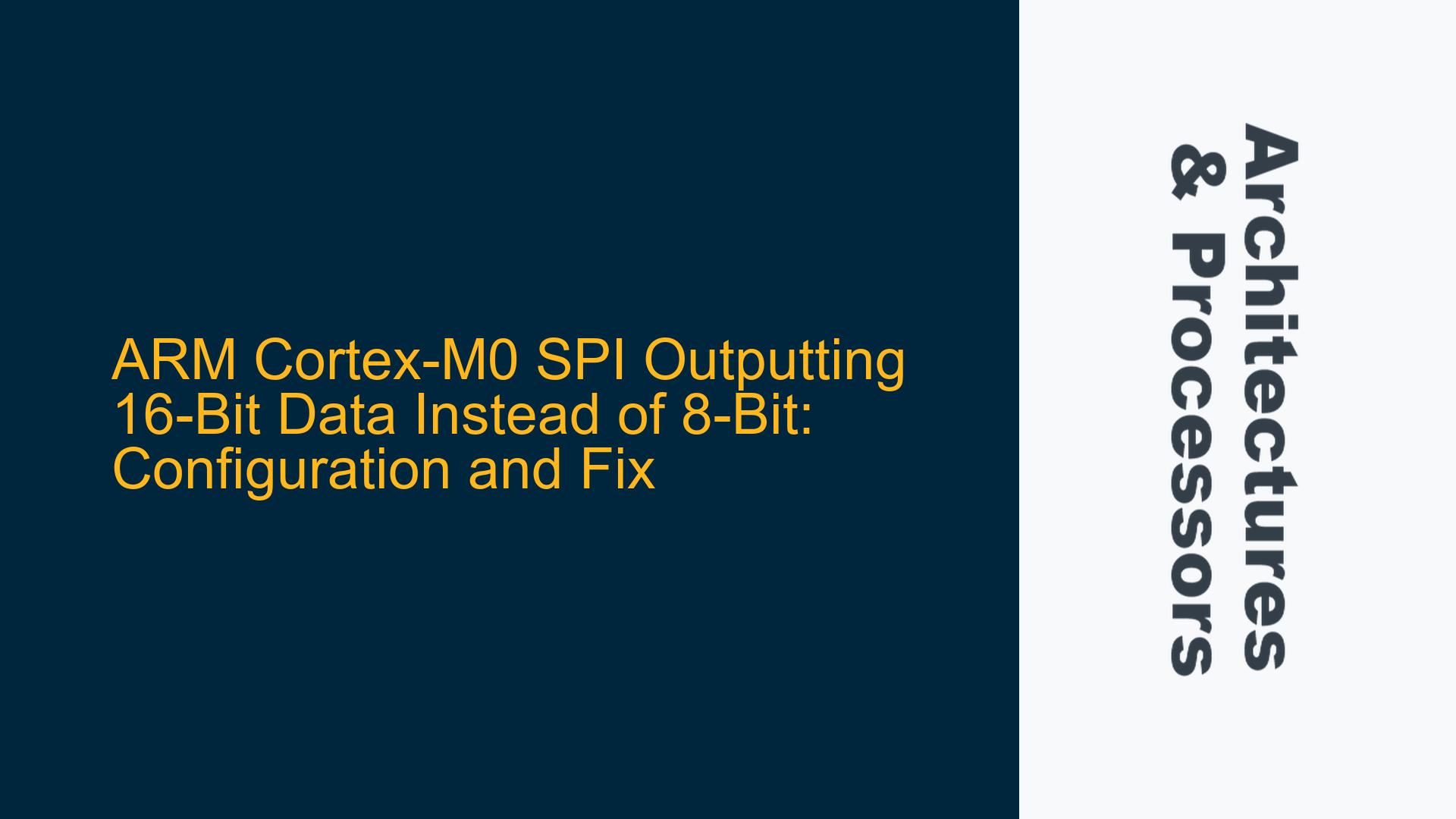SPI Data Frame Size Mismatch in ARM Cortex-M0: 16-Bit Output Instead of 8-Bit
The issue at hand involves the ARM Cortex-M0 processor, specifically the STM32F030K6T6 microcontroller, where the SPI (Serial Peripheral Interface) peripheral is outputting 16-bit data frames instead of the expected 8-bit frames. This discrepancy occurs despite the SPI configuration registers being set to operate in 8-bit data frame mode. The problem manifests when directly manipulating the SPI data register (DR) without ensuring proper data width handling during the write operation. This issue is particularly critical in embedded systems where precise control over data frame size is necessary for communication with peripherals such as sensors, displays, or other microcontrollers.
The SPI protocol is highly configurable, allowing for various data frame sizes, clock polarities, phases, and baud rates. In this case, the SPI configuration registers (CR1 and CR2) are correctly set to operate in 8-bit mode, as evidenced by the initialization code. However, the actual data transmission results in 16-bit frames, indicating a mismatch between the configured data frame size and the hardware behavior during data transfer. This behavior can lead to communication failures with peripherals expecting 8-bit data frames, as the additional bits may be interpreted as invalid or erroneous data.
The root cause lies in the way the SPI data register (DR) is accessed during the write operation. The SPI data register is a 16-bit register, and writing to it without explicitly specifying the data width can result in unintended behavior. In the provided code, the data register is accessed using a 32-bit pointer, which can cause the microcontroller to interpret the write operation as a 16-bit transfer, regardless of the configured data frame size. This highlights a subtle but critical detail in low-level hardware programming: the importance of ensuring that data accesses match the intended data width, especially when dealing with peripherals that have configurable data frame sizes.
Misconfigured Data Register Access and SPI Control Register Settings
The primary cause of the 16-bit data frame output issue is the improper handling of the SPI data register (DR) during the write operation. The SPI data register is a 16-bit register, and its behavior during write operations depends on how it is accessed. When writing to the data register, the microcontroller expects the data to be formatted according to the configured data frame size. However, if the write operation does not explicitly specify the data width, the microcontroller may default to a 16-bit transfer, overriding the configured 8-bit data frame size.
In the provided code, the SPI data register is accessed using a 32-bit pointer, as shown in the following line:
SPI1->DR = chr;
This line writes the 8-bit data (chr) to the SPI data register using a 32-bit pointer. While this may seem innocuous, it can lead to unintended behavior because the microcontroller interprets the write operation as a 16-bit transfer. This occurs because the data register is treated as a 16-bit entity, and the 32-bit pointer causes the microcontroller to write 16 bits of data, even though only 8 bits are intended.
Additionally, the SPI control registers (CR1 and CR2) are configured correctly for 8-bit data frame size, as shown in the initialization code:
SPI1->CR1 = 0x31C; // Master, clk/16, SSM/SSI
SPI1->CR2 = 0x01708; // 8 bit
The CR2 register is set to 0x01708, which configures the SPI peripheral for 8-bit data frames. However, this configuration is effectively overridden by the improper data register access during the write operation. This highlights the importance of ensuring that data accesses match the intended data width, even when the control registers are configured correctly.
Another potential contributing factor is the timing of the write operation relative to the SPI clock and data frame boundaries. If the write operation occurs at an inappropriate time, it may result in unintended behavior, such as the transmission of additional bits. This can be mitigated by ensuring that the write operation is synchronized with the SPI clock and that the data register is accessed in a manner consistent with the configured data frame size.
Correcting Data Register Access and Ensuring Proper SPI Data Frame Size
To resolve the issue of the SPI peripheral outputting 16-bit data frames instead of 8-bit frames, the following steps should be taken:
-
Explicitly Specify Data Width During Write Operations
When writing to the SPI data register, it is essential to explicitly specify the data width to ensure that the microcontroller interprets the write operation correctly. This can be achieved by casting the data register pointer to the appropriate data width. In this case, the data register should be accessed as an 8-bit entity to match the configured data frame size. The corrected write operation is shown below:*(volatile uint8_t *)&SPI1->DR = (uint8_t)chr;This line casts the SPI data register pointer to an 8-bit pointer, ensuring that the write operation is interpreted as an 8-bit transfer. This prevents the microcontroller from defaulting to a 16-bit transfer and ensures that the data frame size matches the configuration.
-
Verify SPI Control Register Settings
Ensure that the SPI control registers (CR1 and CR2) are configured correctly for 8-bit data frame size. The provided initialization code sets theCR2register to0x01708, which configures the SPI peripheral for 8-bit data frames. This configuration should be verified to ensure that it is applied correctly and that no other settings are overriding it. -
Synchronize Write Operations with SPI Clock
Ensure that the write operation is synchronized with the SPI clock to prevent unintended behavior. This can be achieved by waiting for the TXE (Transmit Buffer Empty) bit to set before writing to the data register, as shown in the corrected code:while ((SPI1->SR & SPI_SR_TXE) == 0); // wait for TXE bit to set *(volatile uint8_t *)&SPI1->DR = (uint8_t)chr;This ensures that the write operation occurs at the appropriate time relative to the SPI clock and data frame boundaries.
-
Monitor SPI Status Flags
Monitor the SPI status flags to ensure that the data transfer is completed successfully. The provided code includes checks for the RXNE (Receive Buffer Not Empty) and BSY (Busy) flags to ensure that the SPI peripheral is not busy and that the data transfer is complete. These checks should be retained to ensure reliable operation:while ((SPI1->SR & SPI_SR_RXNE) == 0); while ((SPI1->SR & SPI_SR_BSY) != 0); // wait for BSY bit to Reset -
Test and Validate the Solution
After implementing the above changes, test the SPI peripheral to ensure that it is outputting 8-bit data frames as expected. Use a logic analyzer or oscilloscope to verify the data frame size and ensure that the communication with peripherals is functioning correctly.
By following these steps, the issue of the SPI peripheral outputting 16-bit data frames instead of 8-bit frames can be resolved. The key takeaway is the importance of ensuring that data accesses match the intended data width, especially when dealing with configurable peripherals like SPI. Proper handling of the data register and synchronization with the SPI clock are critical to achieving reliable operation.
Summary of Key Points
| Aspect | Details |
|---|---|
| Issue | SPI outputs 16-bit data frames instead of 8-bit frames. |
| Root Cause | Improper handling of SPI data register access during write operations. |
| Solution | Explicitly specify data width during write operations. |
| Critical Steps | Cast data register pointer to 8-bit, verify control register settings. |
| Testing | Use logic analyzer to validate 8-bit data frame output. |
By addressing the root cause and implementing the recommended fixes, the SPI peripheral can be configured to output 8-bit data frames reliably, ensuring proper communication with peripherals and avoiding unintended behavior.






